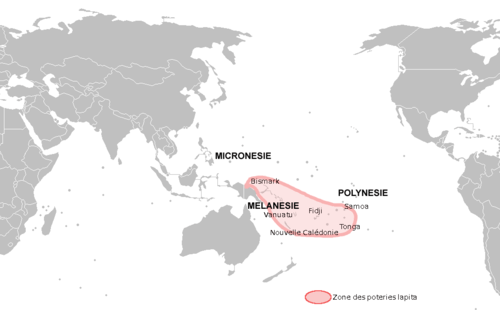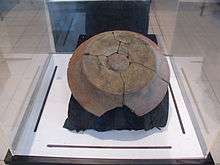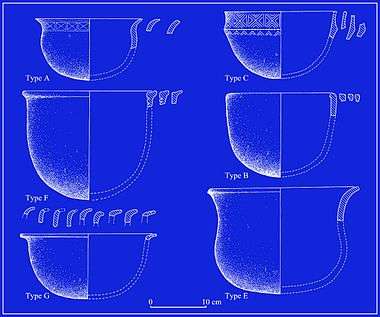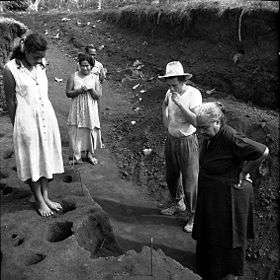Lapita culture
The Lapita culture was a prehistoric Pacific Ocean people who flourished in the Pacific Islands from about 1600 BCE to about 500 BCE. Archaeologists believe that the Lapita are the ancestors of historic cultures in Polynesia, Micronesia, and some coastal areas of Melanesia. The characteristics of the Lapita culture are the extension of human settlement to previously uninhabited islands scattered over a large area in the Pacific Ocean, the spread of Oceanic languages in that area, the distinctive geometric dentate-stamped pottery, and the use and widespread distribution of obsidian.


The Lapita were expert seafarers and navigators, reaching out and finding islands separated from each other by hundreds of kilometres of empty ocean. Their descendants, the Polynesians, went on to populate islands across the Pacific, ranging from New Zealand to Hawaii and Easter Island.
Etymology
The term 'Lapita' was coined by archaeologists after mishearing a word in the local Haveke language, xapeta'a, which means 'to dig a hole' or 'the place where one digs', during the 1952 excavation in New Caledonia.[1][2] The Lapita archaeological culture is named after the type site where it was first uncovered in the Foué peninsula on Grande Terre, the main island of New Caledonia. The excavation was carried out in 1952 by American archaeologists Edward W. Gifford and Richard Shulter Jr at 'Site 13'.[1] The settlement and pottery sherds were later dated to 800 BCE and proved significant in research on the early peopling of the Pacific Islands. More than 200 Lapita sites have since been uncovered,[3] ranging more than 4,000 km from coastal and island Melanesia to Fiji and Tonga with its most eastern limit so far in Samoa.
Dating
'Classic' Lapita pottery was produced between 1350 and 750 BCE in the Bismarck Archipelago. A late variety might have been produced there up to 250 BCE. Local styles of Lapita pottery are found in the Solomon Islands,[4] Vanuatu and New Caledonia. Pottery persisted in Fiji, whereas it disappeared completely in other areas of Melanesia and in Siassi.
In Western Polynesia, Lapita pottery is found from 800 BCE onwards in the Fiji-Samoa-Tonga area. From Tonga and Samoa, Polynesian culture spread to Eastern Polynesia areas, including the Marquesas and the Society Islands, and then later to Hawaii, Easter Island, and New Zealand. However, pottery-making did not persist in most of Polynesia, mainly due to the lack of suitable clay on small islands.
Material culture


These pots were usually created by any materials that were accessible, as well as the techniques used to make such detailed designs.[5] The low-fired earthenware pottery, often tempered with shell or sand, is typically decorated with a dentate (toothed) stamp. It has been theorized[6] that these decorations may have been transferred to or from less hardy media such as tapa (bark cloth), mats, or tattoos. Undecorated "plain-ware" pottery is an important part of the Lapita cultural complex, which also includes ground-stone adzes and shell artifacts, and flaked-stone tools of obsidian, chert, and other available rock, as well as the remainders of beakers, cooking pots, and bowls.[7]
Economy
Domesticates consisted of pigs, dogs, and chickens. Horticulture was based on root crops and tree crops, most importantly taro and yam, coconuts, bananas, and varieties of breadfruit. This was supplemented by fishing and mollusc gathering. Long-distance trade of obsidian[8], adzes, and favourable adze source rock and shells was practiced.
Burial customs
Excavation of a large cemetery at Teouma on Efate Island in Vanuatu, discovered in 2003, found 36 bodies in 25 graves, as well as burial jars. All skeletons were headless with the skulls removed after original burial and replaced with rings made from cone shell. The heads were reburied. One burial of an elderly man had three skulls lined up on his chest. One burial jar featured four birds looking into the jar. Carbon dating of the shells placed this cemetery at about 1000 BC.[9]
Settlements
In the west, villages were located on small offshore islands or the beaches of larger islands. This may have been to avoid areas already settled in coastal New Guinea, or malaria-carrying mosquitoes for which Lapita people had no immune defence. Some houses were built on stilts over larger lagoons. In New Britain, settlements are found inland, as well, near the obsidian sources. In the eastern archipelago, all settlements are located on land, sometimes some distance inland.
Distribution

Lapita pottery is known from the Bismarck archipelago to Samoa and Tonga. Currently, the most eastern Lapita site is Mulifanua in Samoa, where 4,288 pottery sherds and two Lapita type adzes have been recovered. The site has a true age of circa 3,000 BP based on 14C dating on a shell.[10] The domesticates spread into farther Oceania, as well. Humans, their domesticates, and species that were introduced involuntarily (perhaps as the Polynesian rat was) led to extinctions of endemic species on many islands, especially of flightless birds.
Language
Researchers suppose that the "Lapita people" spoke proto-Oceanic, a precursor of the Oceanic branch of Austronesian. However, given the difficulty of linking nonliterate material culture to languages, this attribution cannot be verified by independent sources.
Origin
.png)
An ultimate Southeast Asian origin of the Lapita complex is assumed by most scholars, perhaps originating from the Austronesians in Taiwan or southern China some 5,000 to 6,000 years ago. This Neolithic dispersal was driven by a rapid population growth in east and southeast Asia (Formosa), and has often been called 'the express-train to Polynesia'. Burial pottery similar to "red slip" pottery of Taiwan, as well as detailed linguistic evidence,[12] seem to lend support to this theory.[9]
The orthodox view, argued for by people such as Roger Green and Peter Bellwood, proposes a Triple-I model, where Lapita arose from this Austronesian expansion through a process of Intrusion into new territories, Innovation of new technologies (such as the outrigger canoe), and Integration with the existing populations.[13]
Direct links between Lapita and mainland Southeast Asia are still missing, due to a lack of data in Indonesia and Malaysia. In 2016, DNA analysis of four Lapita skeletons from old cemeteries on Vanuatu and Tonga showed that the Lapita people descended from peoples of East Asia and came to the islands through Taiwan and Philippines.[14]
Other scholars such as J. Allen located the origin of the Lapita complex in the Bismarck Archipelago that was first colonised 30,000 to 35,000 BCE. Others see obsidian trade as the motor of the spread of Lapita elements in the western distribution area.
In 2011, Bellwood proposed that the initial movement of Malayo-Polynesian speakers into Oceania went from the northern Philippines eastwards to the Mariana Islands, then from there southwards into the Bismarcks.[15]
Lapita in Polynesia
As the archaeological record improved in the 1980s and 1990s, the Lapita people were found to be the original settlers in Melanesia and western Polynesia.[16] Many scientists believe Lapita pottery in Melanesia to be proof that Polynesian ancestors passed through this area on their way into the central Pacific. The earliest archaeological site in Polynesia is in Mulifanua and Sasoa'a, Falefa in Samoa, with carbon dating of both sites placing the date of settlement to between 2900–3500 years ago.[17]
Other early Lapita discovery sites dating back to 900 BCE are also found in Tonga and contains the typical pottery and other archaeological "kit" of Lapita sites in Fiji and eastern Melanesia of about that time and immediately before.[18][19]
Anita Smith compares the Polynesian Lapita period with the later Polynesian Plainware ceramic period in Polynesia:
“There do not appear to be new or different kinds of evidence associated with plain-ware ceramics (& lapita), only the disappearance of a minor component of material culture and faunal assemblages is apparent. There is continuity in most aspects of the archaeological record that appears to mimic post Lapita sequences of Fiji and island Melanesia (Mangaasi and Naviti pottery).”[19]
Plainware pottery is found on many Western Polynesian islands and marks a transitional period between when only Lapita pottery was found and a later period before the settlement of Eastern Polynesia when the Western Polynesians of the time had given up pottery production altogether. Archaeological evidence indicates that plainware pottery ceases abruptly in Samoa around 0.
According to Smith:
“Ceramics were not manufactured by Polynesian societies at any time in East Polynesian prehistory.”[19]
Matthew Spriggs stated: "The possibility of cultural continuity between Lapita Potters and Melanesians has not been given the consideration it deserves. In most sites there was an overlap of styles with no stratigraphic separation discernible. Continuity is found in pottery temper, importation of obsidian and in non-ceramic artefacts".[20]
See also
- Teouma – a major archaeological site in Vanuatu
- Archaeology in Samoa
- Early history of Tonga
References
- West, Barbara A. (2008). Encyclopedia of the Peoples of Asia and Oceania, Volume 1. Infobase Publishing. p. 460. ISBN 9780816071098. Retrieved 29 December 2010.
- Mortaigne, Véronique (28 December 2010). "Lapita: Oceanic Ancestors – review". Guardian UK. Originally appeared in Le Monde. Retrieved 29 December 2010.
- Sand, Christophe; Sean P. Connaughton (2007). Oceanic explorations: Lapita and western Pacific settlement. Australia: ANU E Press. pp. 3–29. ISBN 9780975122907.
- Reading Lapita in near Oceania : intertidal and shallow-water pottery scatters, Roviana Lagoon, New Georgia, Solomon Islands (Thesis). ResearchSpace@Auckland. 2003. hdl:2292/997.
- Chiu, Scarlett (2003). The Socio -Economic Functions of Lapita Ceramic Production and Exchange: A Case Study from Site WKO013A, Koné, New Caledonia (Thesis). ProQuest 305336522.
- Kirch, Patrick Vinton (2012). A Shark Going Inland is my Chief. Berkeley, CA: University of California Press. pp. 21–37. ISBN 978-0-520-27330-6.
- "Lapita Culture." Encyclopædia Britannica School and Library Subscribers, best modified 26 February 2016. https://www.britannica.com/topic/Lapita-culture accessed 1 November 2016.
- Specht, Jim (2018). "Research issues in the circum-New Guinea islands". In Cochrane, Ethan E.; Hunt, Terry L. (eds.). The Oxford Handbook of Prehistoric Oceania. Oxford University Press. p. 100. ISBN 978-0-19-992507-0.
- Graves of the Pacific's First Seafarers Revealed, Richard Stone, Science Magazine, 21 April 2006: Vol. 312. no. 5772, p. 360
- New Information for the Ferry Berth Site, Mulifanua, Western Samoa by Roger C. Green and Helen M. Leach, Journal of the Polynesian Society, Vol. 98, 1989, No. 3. Retrieved 1 November 2009
- Chambers, Geoff (2013). "Genetics and the Origins of the Polynesians". eLS. John Wiley & Sons, Inc. doi:10.1002/9780470015902.a0020808.pub2. ISBN 978-0470016176.
- Blust, R. (1999). "Subgrouping, circularity and extinction: some issues in Austronesian comparative linguistics". In E. Zeitoun and P. J.-K. Li. (ed.). Selected Papers from the Eighth International Conference on Austronesian Linguistics. Taipei: Symposium Series of the Institute of Linguistics, Academia Sinica..
- Greenhill, S. J. & Gray, R.D. (2005).Testing Population Dispersal Hypotheses: Pacific Settlement, Phylogenetic Trees, and Austronesian Languages. In: The Evolution of Cultural Diversity: Phylogenetic Approaches. Editors: R. Mace, C. Holden, & S. Shennan. Publisher: UCL Press. Archived 28 September 2011 at the Wayback Machine
- "Origins of Vanuatu and Tonga's first people revealed". 4 October 2016. Retrieved 5 October 2016.
- Bellwood, Peter (2011). "The Checkered Prehistory of Rice Movement Southwards as a Domesticated Cereal—from the Yangzi to the Equator". Rice. 4 (3): 93–103. doi:10.1007/s12284-011-9068-9.
- Andrew Pawley. "The Origins of Early Lapita Culture: The Testimony of Historical Linguistics," in Terra Australis, volume 26 edited by Stuart Bedford, Christophe Sand, and Sean P. Connaughton, 19. 26th ed. (Canberra: ANU E Press, 2007), 1-15.
- Dickinson, William R.; Green, Roger C. (February 1998). "Geoarchaeological context of Holocene subsidence at the Ferry Berth Lapita site, Mulifanua, Upolu, Samoa". Geoarchaeology. 13 (3): 239–263. doi:10.1002/(sici)1520-6548(199802)13:3<239::aid-gea1>3.0.co;2-5. ISSN 0883-6353.
- Burley, David V.; Barton, Andrew; Dickinson, William R.; Connaughton, Sean P.; Taché, Karine (2010). "Nukuleka as a Founder Colony for West Polynesian Settlement: New Insights from Recent Excavations". Journal of Pacific Archaeology. 1 (2): 128–144.
- Anita Smith, An Archaeology of West Polynesian Prehistory, 2002.
- Matthew Spriggs, The Lapita Cultural Complex, 1985.
Sources
- Allen, J. (1984). "In Search of the Lapita Homeland: Reconstructing the Prehistory of the Bismarck Archipelago". Journal of Pacific History. 19 (4): 186–187. doi:10.1080/00223348408572494.
- Bellwood, P. (1978). Man's conquest of the Pacific. London: Collins.
- Chino, K. (2002). "Lapita Pottery – Ties in the South Pacific". Wave of Pacifika. 8.
- Clark, G.; A. Anderson; T. Vunidilo (June 2000). The archaeology of Lapita dispersal in Oceania: papers from the 4th Lapita conference. Canberra: Pandanus Books. pp. 15–23.
- Kirch, Patrick Vinton (1997). The Lapita Peoples: Ancestors of the Oceanic World. Oxford: Blackwell.
- Noury, A. (2005). Le reflet de l'ame Lapita. Paris: Noury. ISBN 978-2-9524455-0-4.
- Summerhayes, Glenn R. (2000). "Far Western, Western and Eastern Lapita: A re-evaluation" (PDF). Asian Perspectives. 39 (39/1–2): 109–138. doi:10.1353/asi.2000.0013. hdl:10125/17136.
- Noury, Arnaud; Galipaud J.-C. (2011). Les Lapita, nomades du Pacifique (french). France: IRD Editions.
- Noury, Arnaud (2012). Grammaire des décors lapita (french). France: Andromaque Editions.
- Noury, Arnaud (2013). Le Lapita : a l'origine des sociétés d'Oceanie (french). France: Lulu eds.
- Felgate, Matthew (2003) Reading Lapita in near Oceania : intertidal and shallow-water pottery scatters, Roviana Lagoon, New Georgia, Solomon Islands. University of Auckland PhD Thesis
External links
| Wikimedia Commons has media related to Lapita Culture. |
- Lapita cultural complex – brief description with picture of pottery (Central Queensland University School of Humanities)
- Extinctions connected with the spread of Lapita (Proceedings of the National Academy of Sciences)
- Lapita cultural complex, Lapita designs, texts about Lapita, LapitaDraw ("software to aid in studying archaeological ceramic artefacts") (Archéologie et Informatique, in French)
- 'Heads found in pots in Vanuatu dig', ANU media release, 14 July 2005, on discovery of Lapita skulls following 2004 find of headless Lapita skeletons
- Over 1000 Lapita photographs from the University of Auckland Anthropology Photographic Archive database. Search for "lapita"


.jpg)